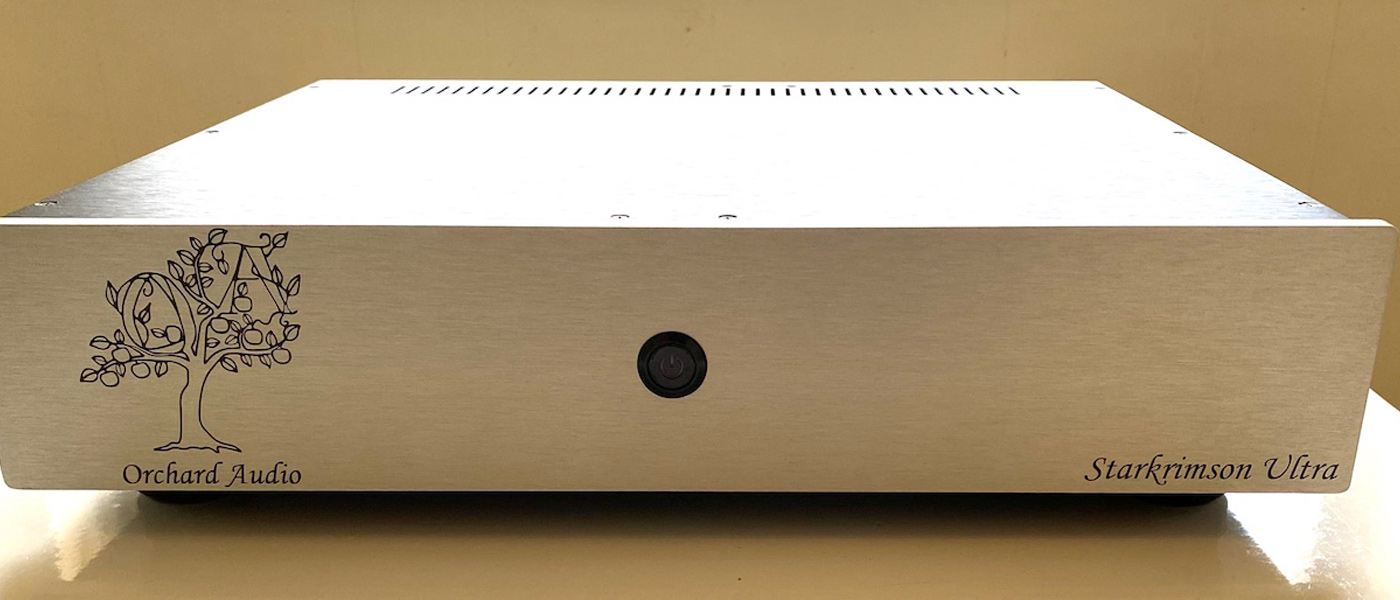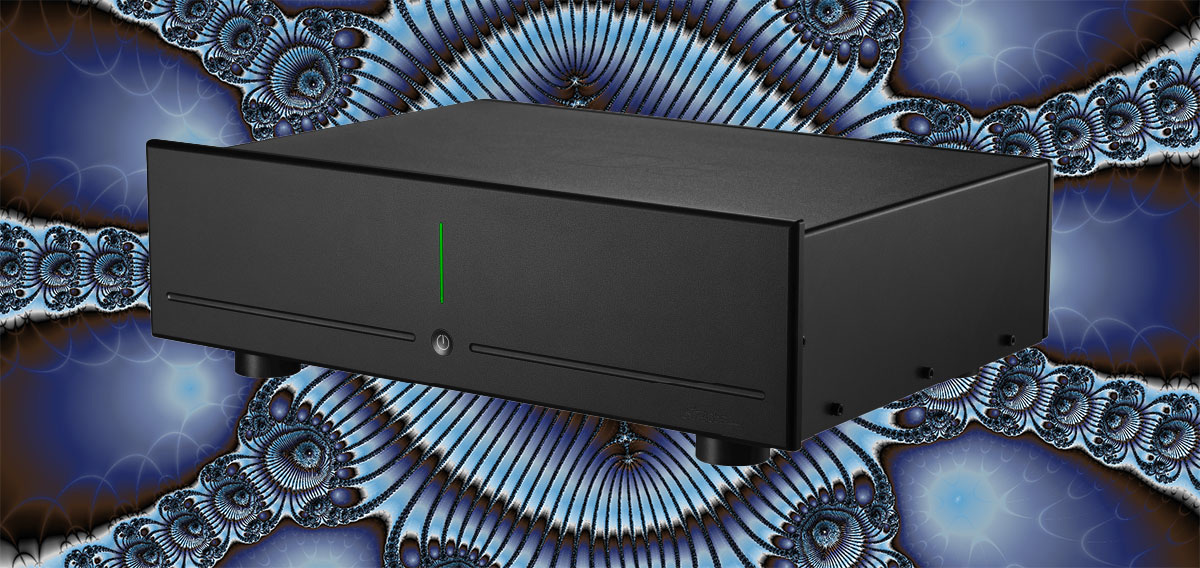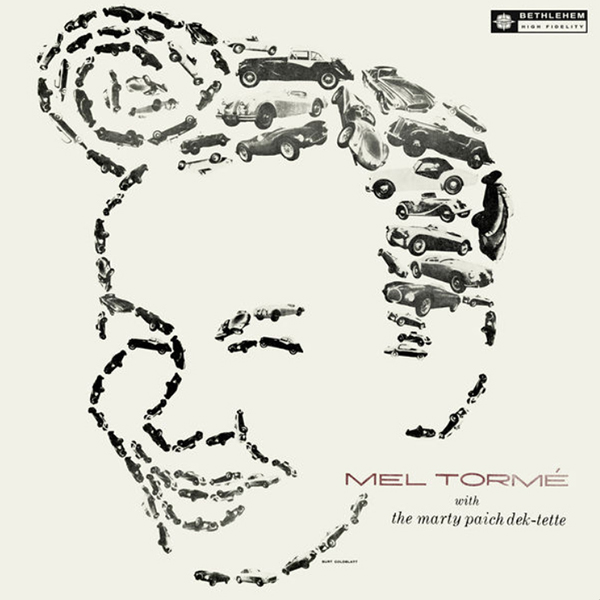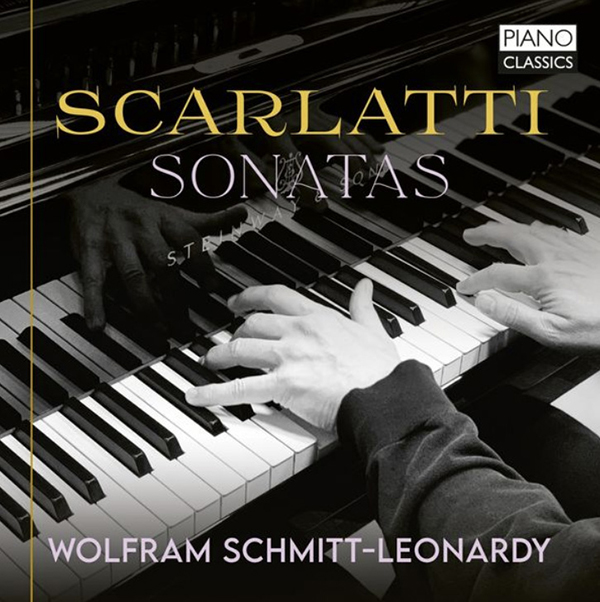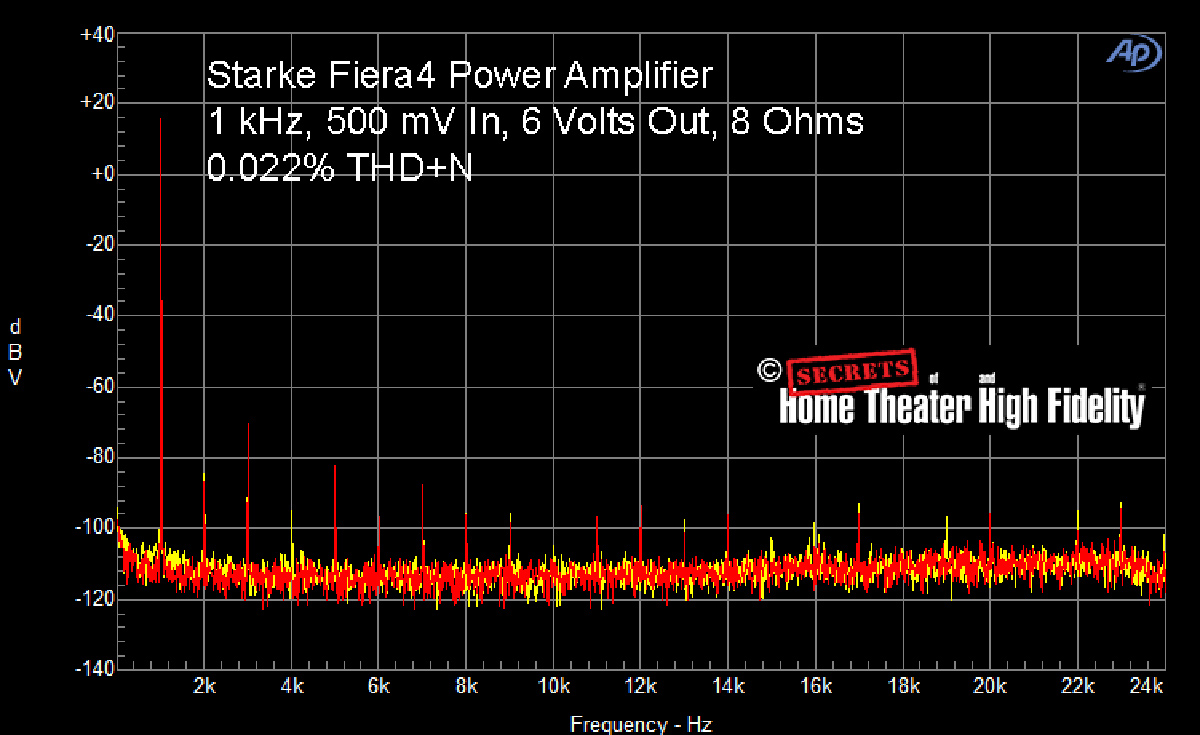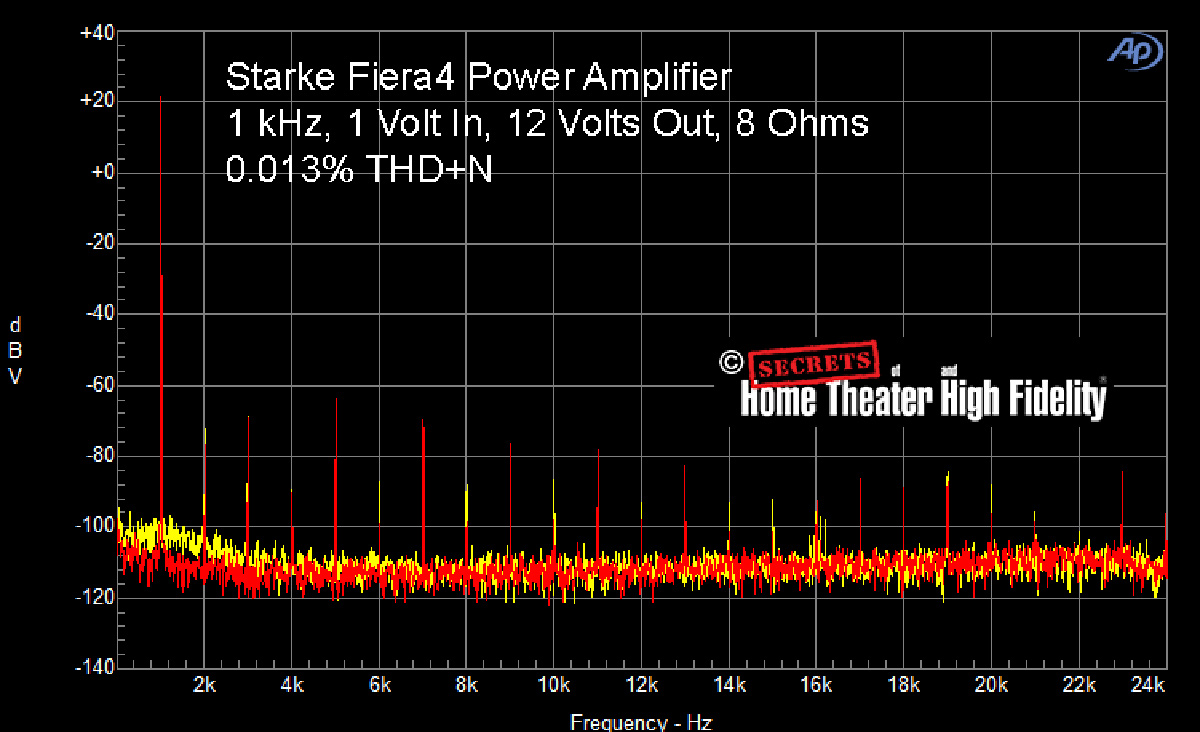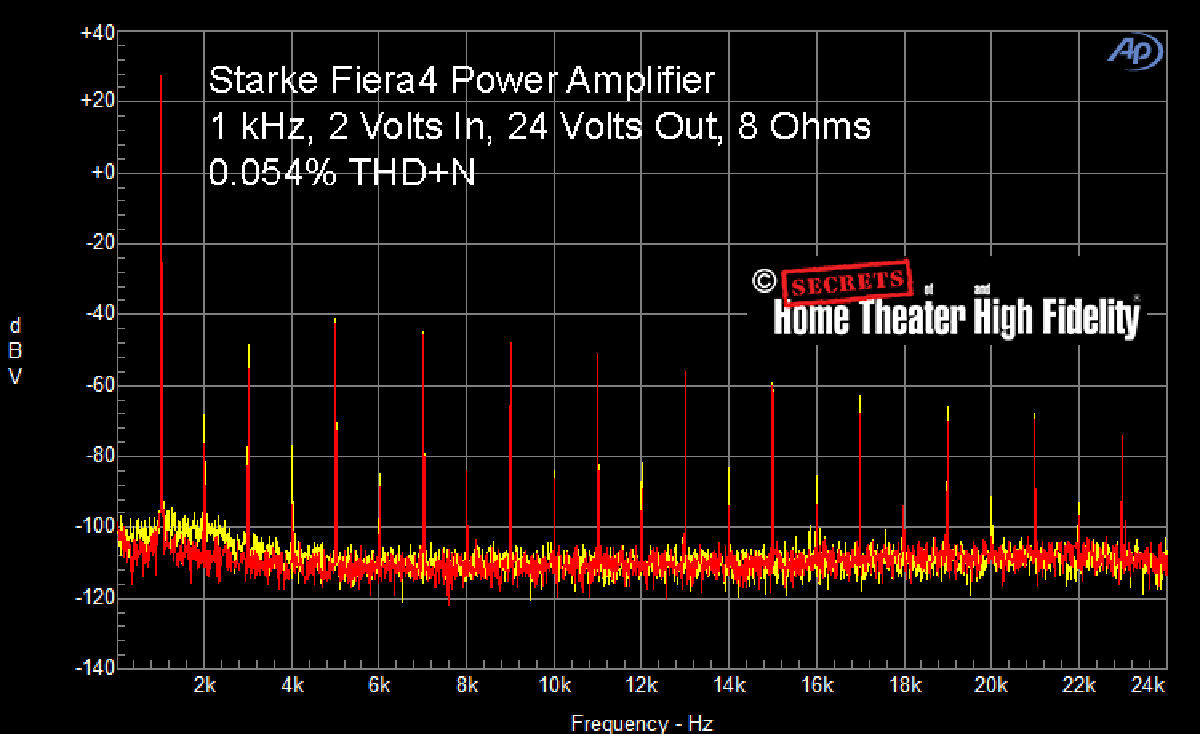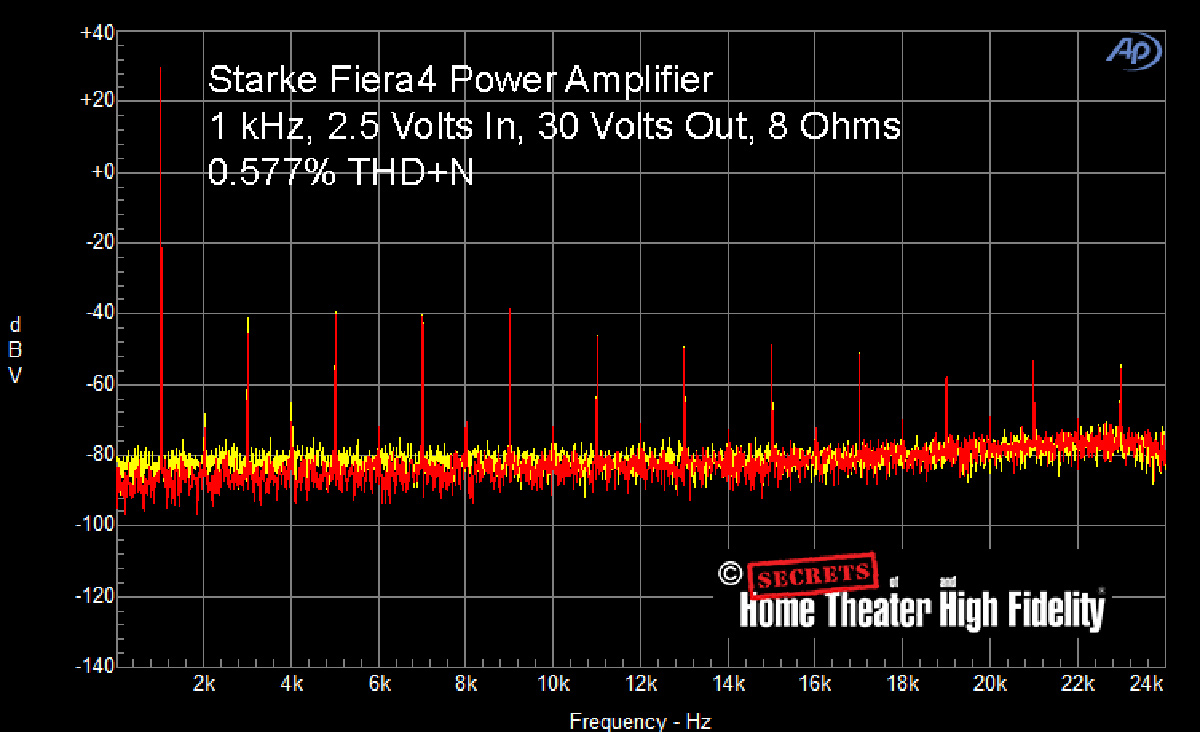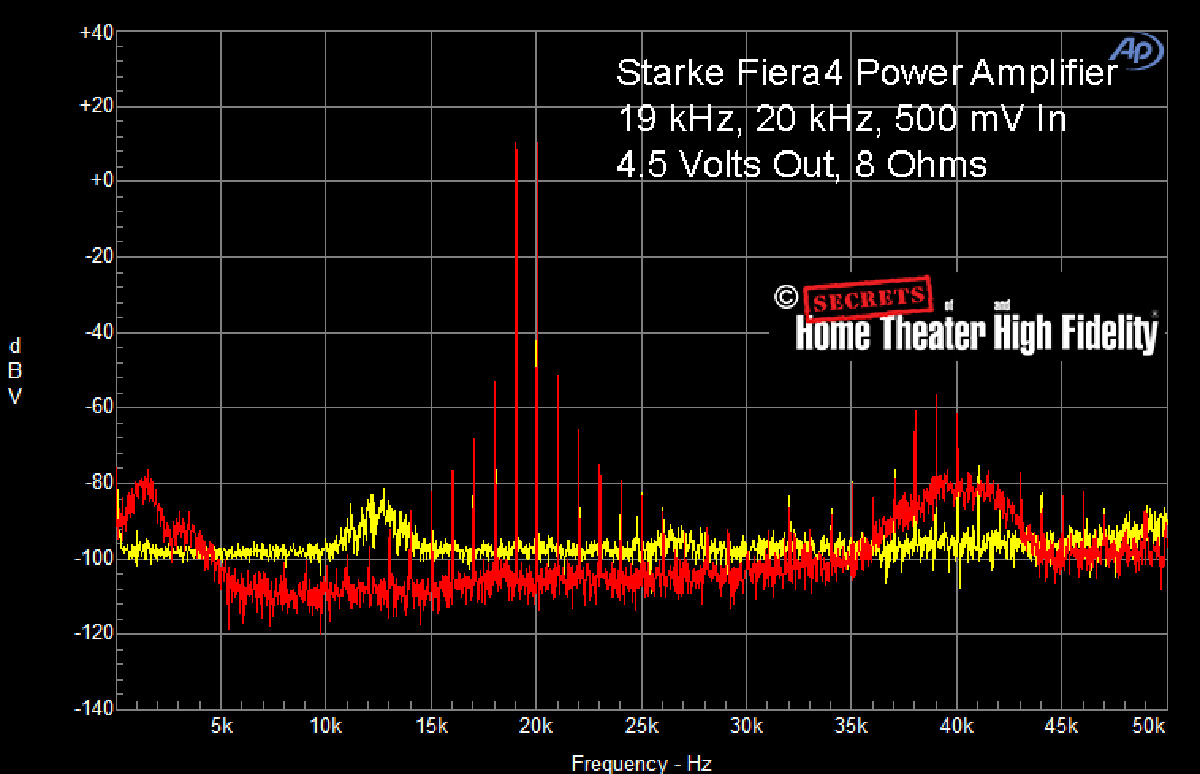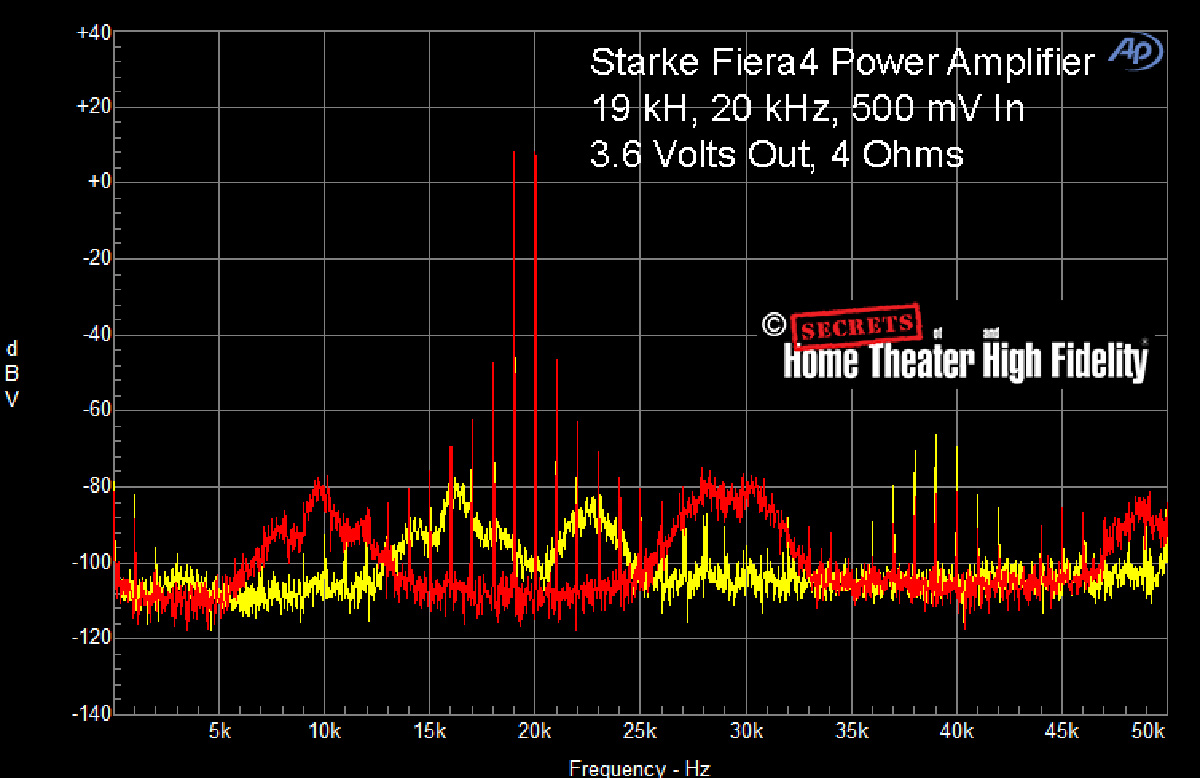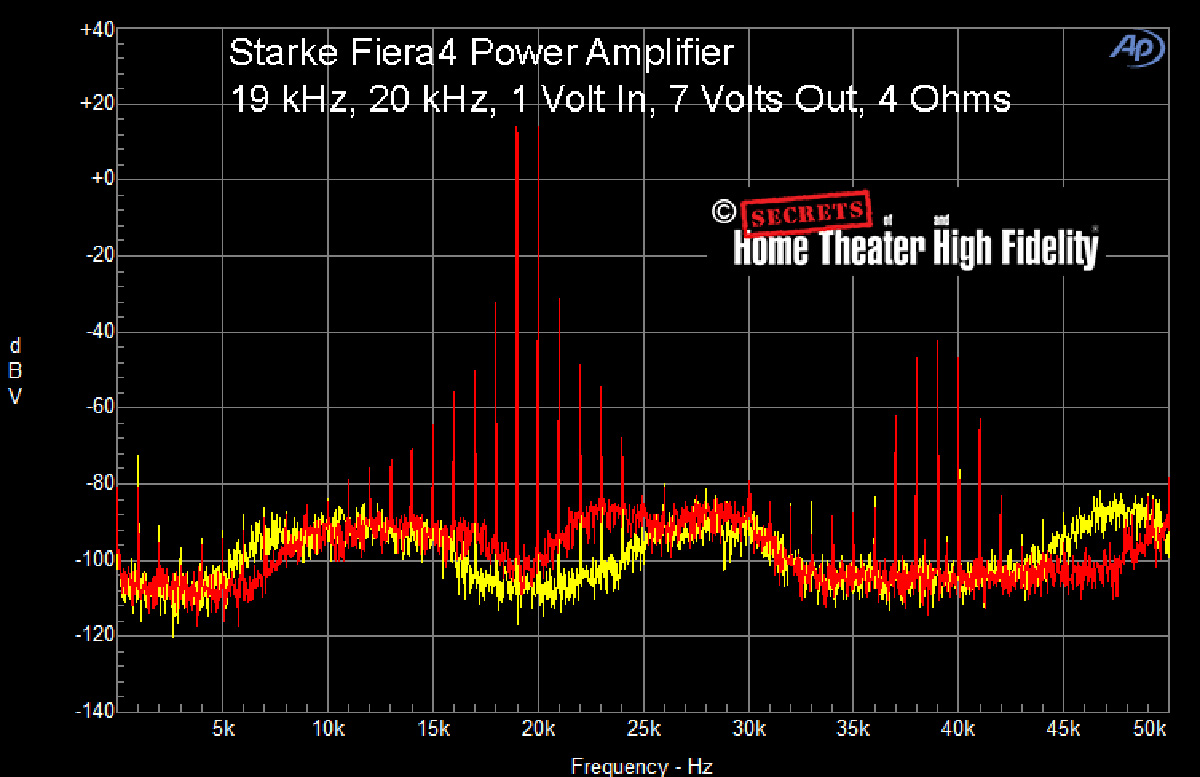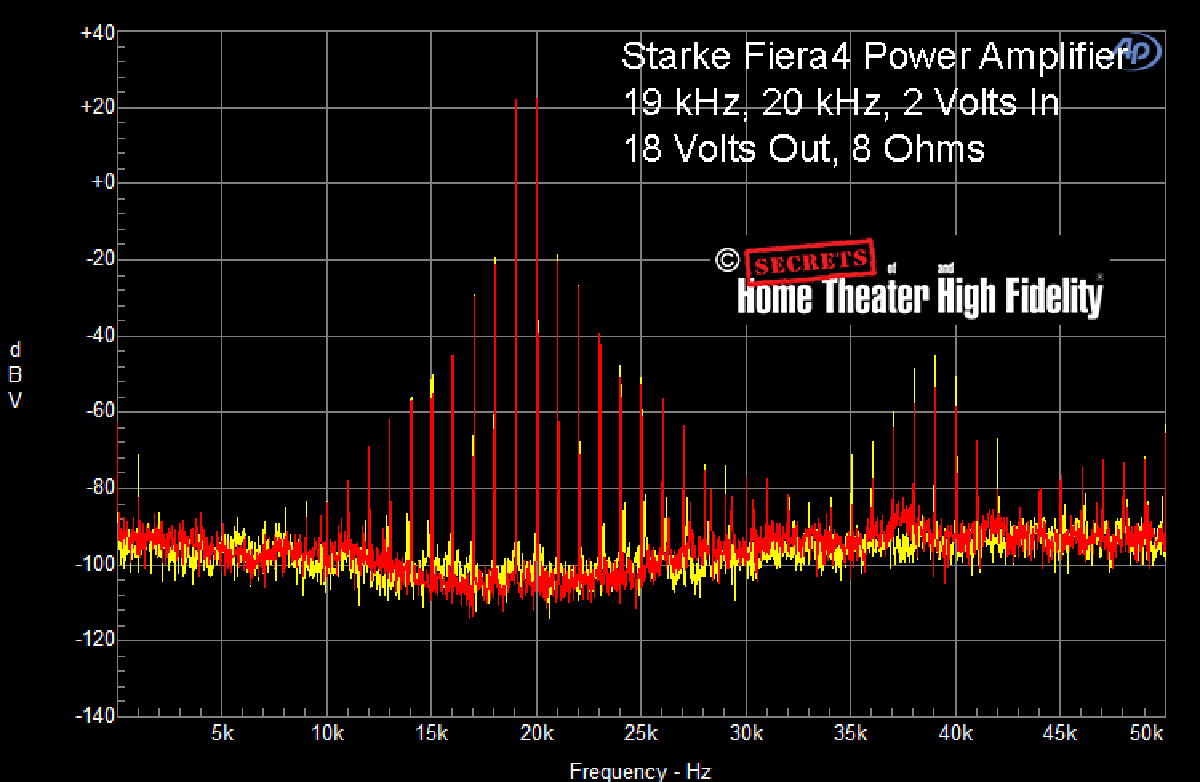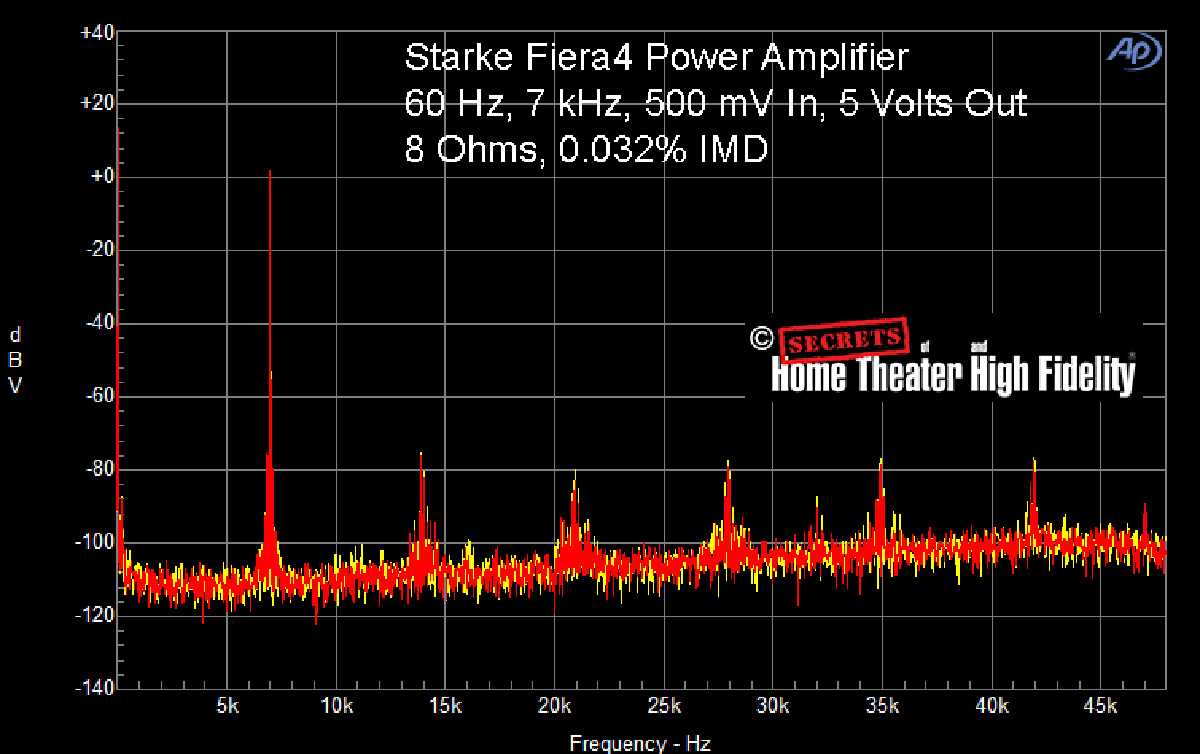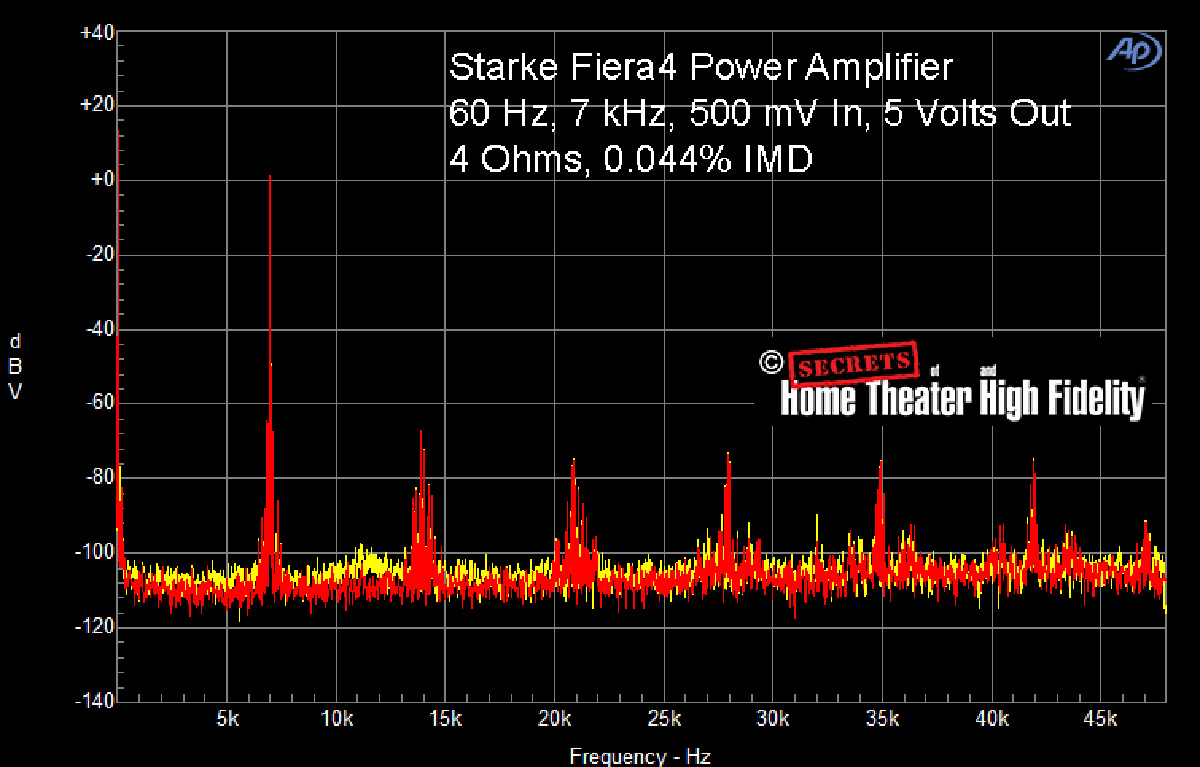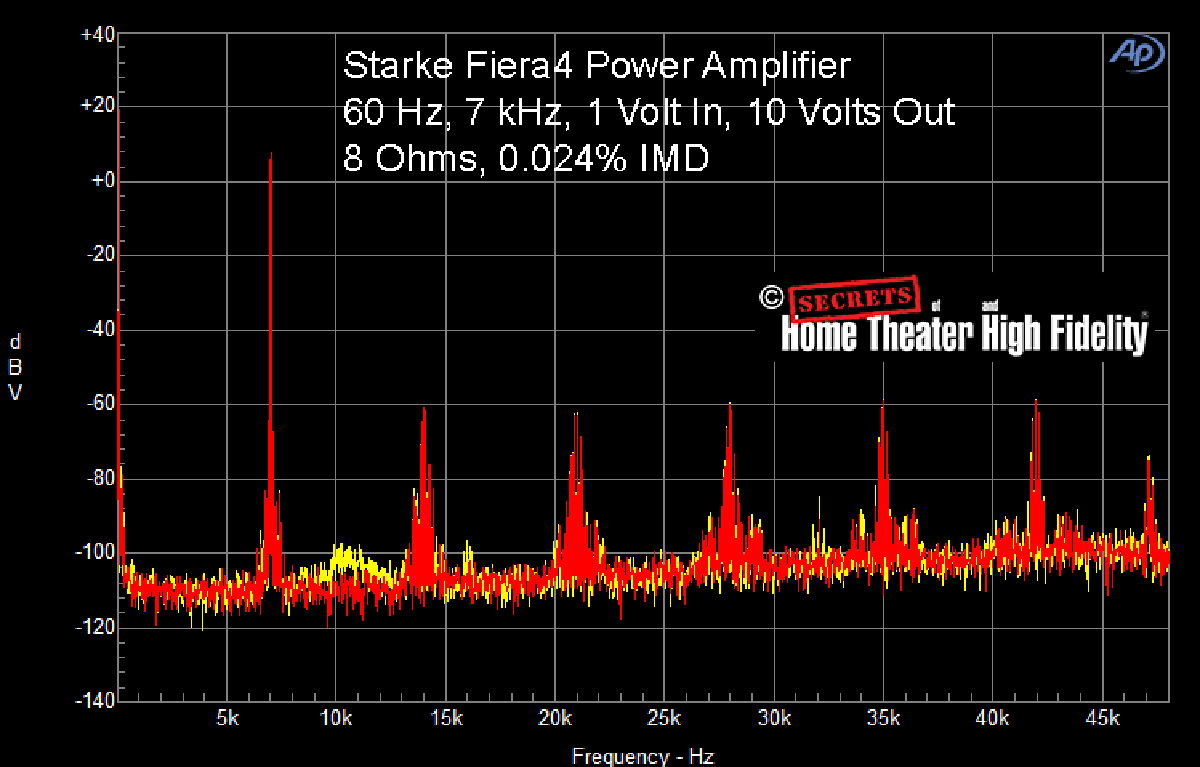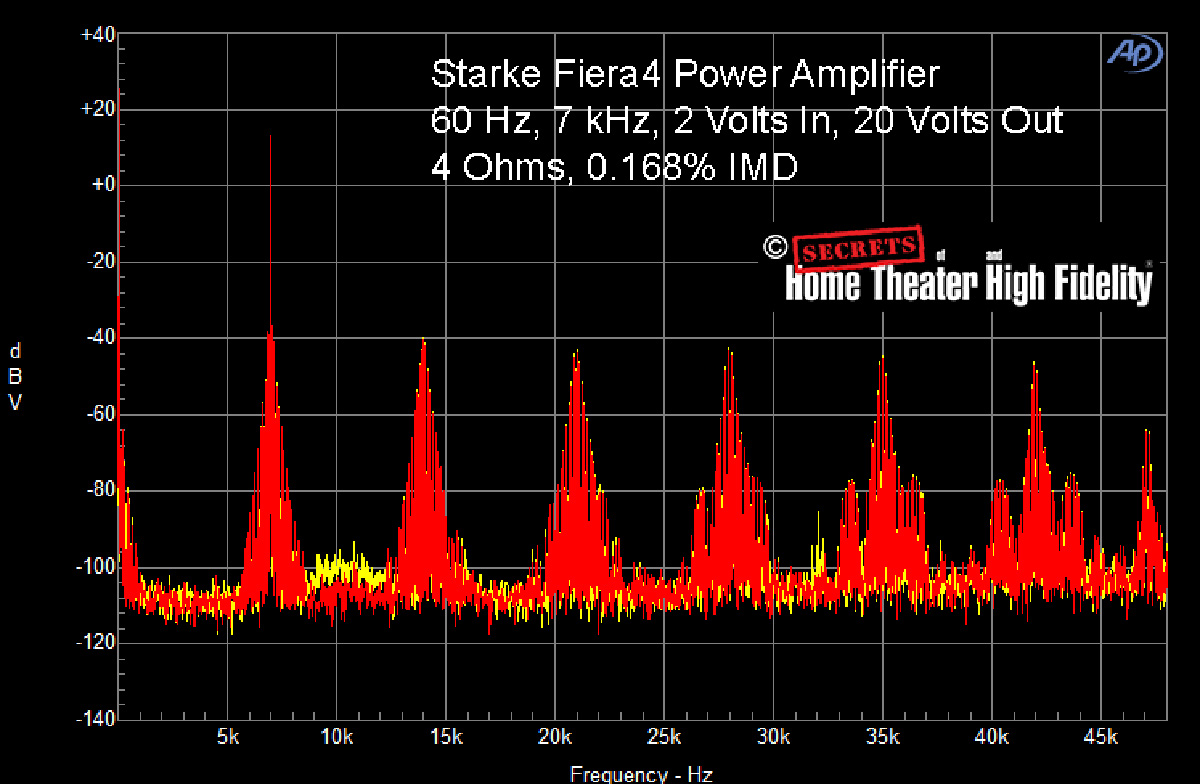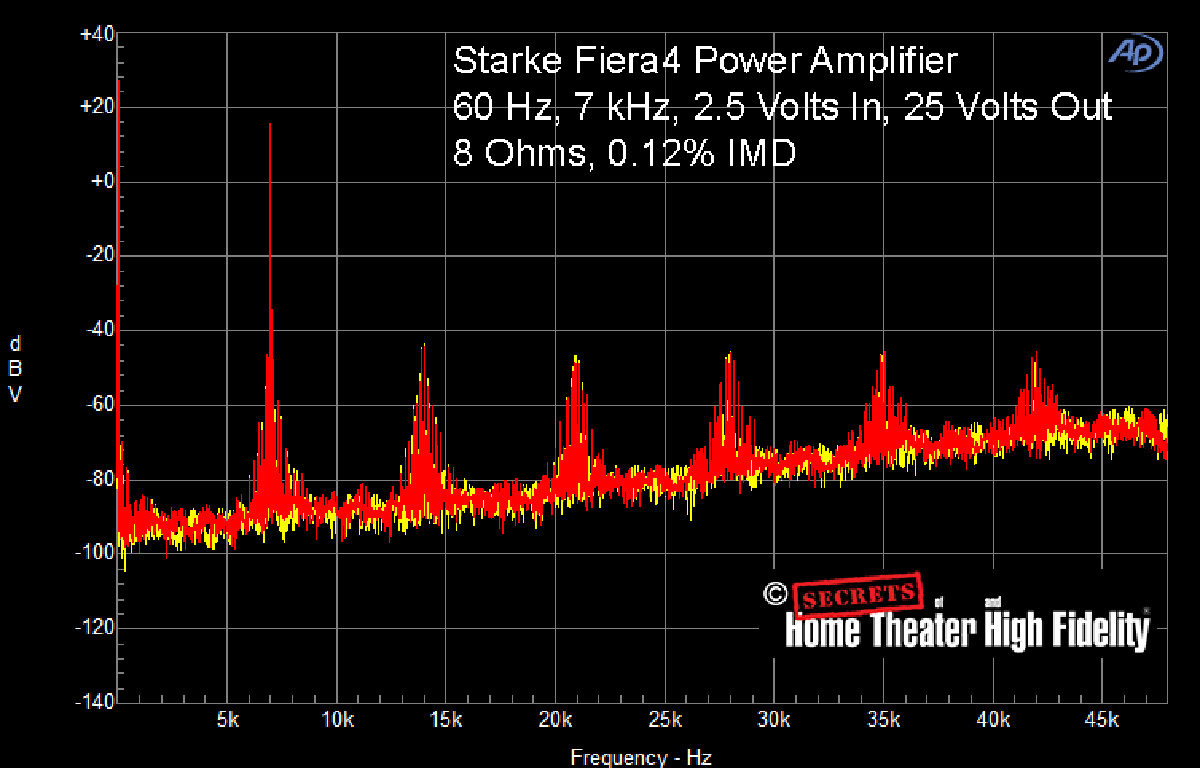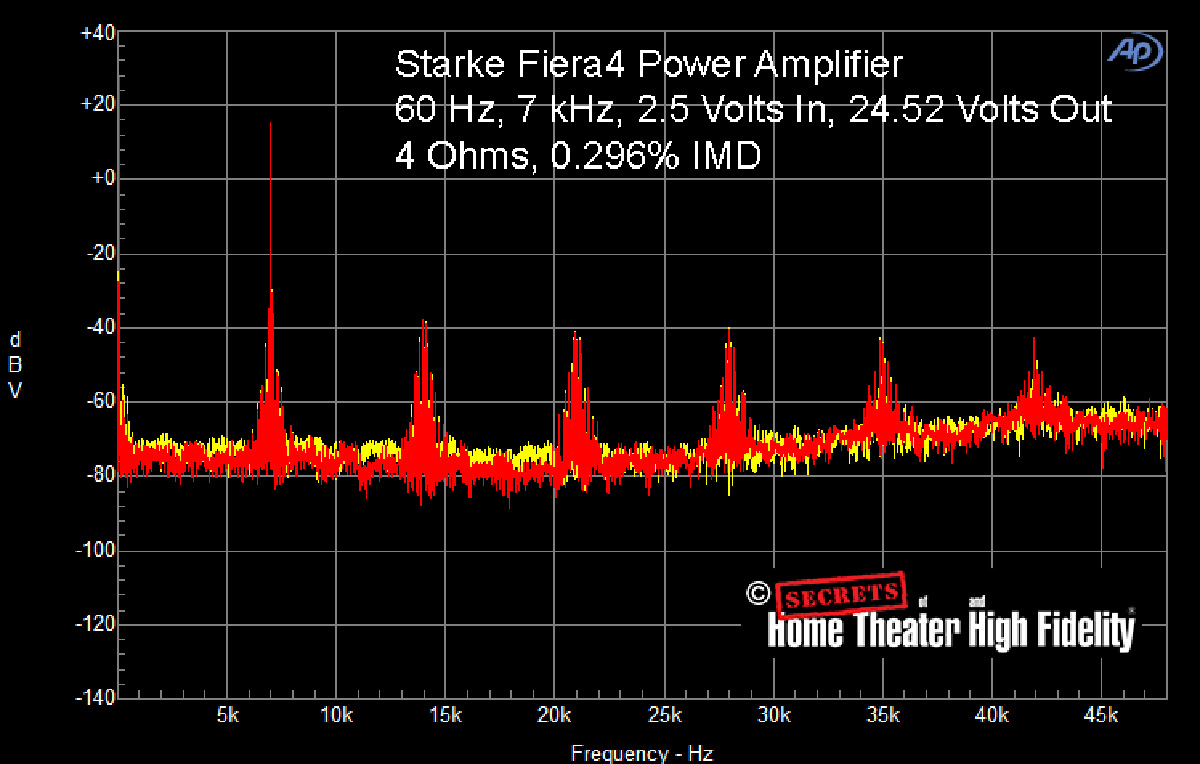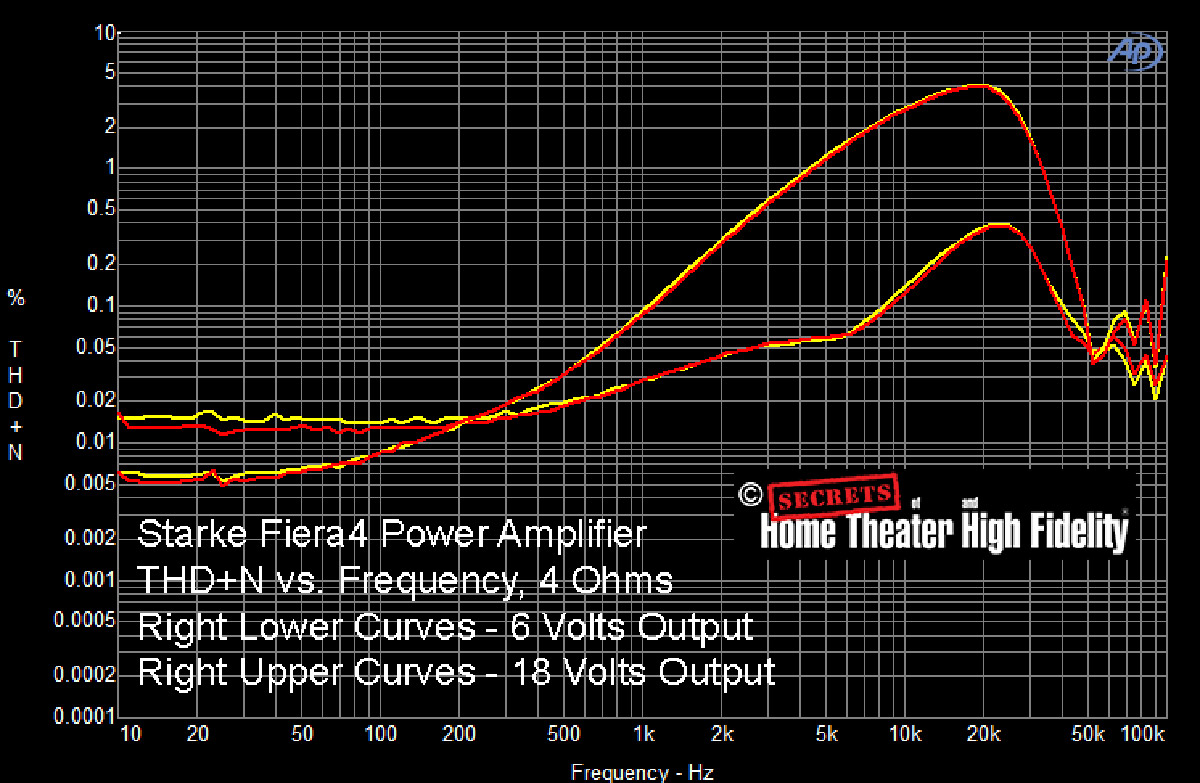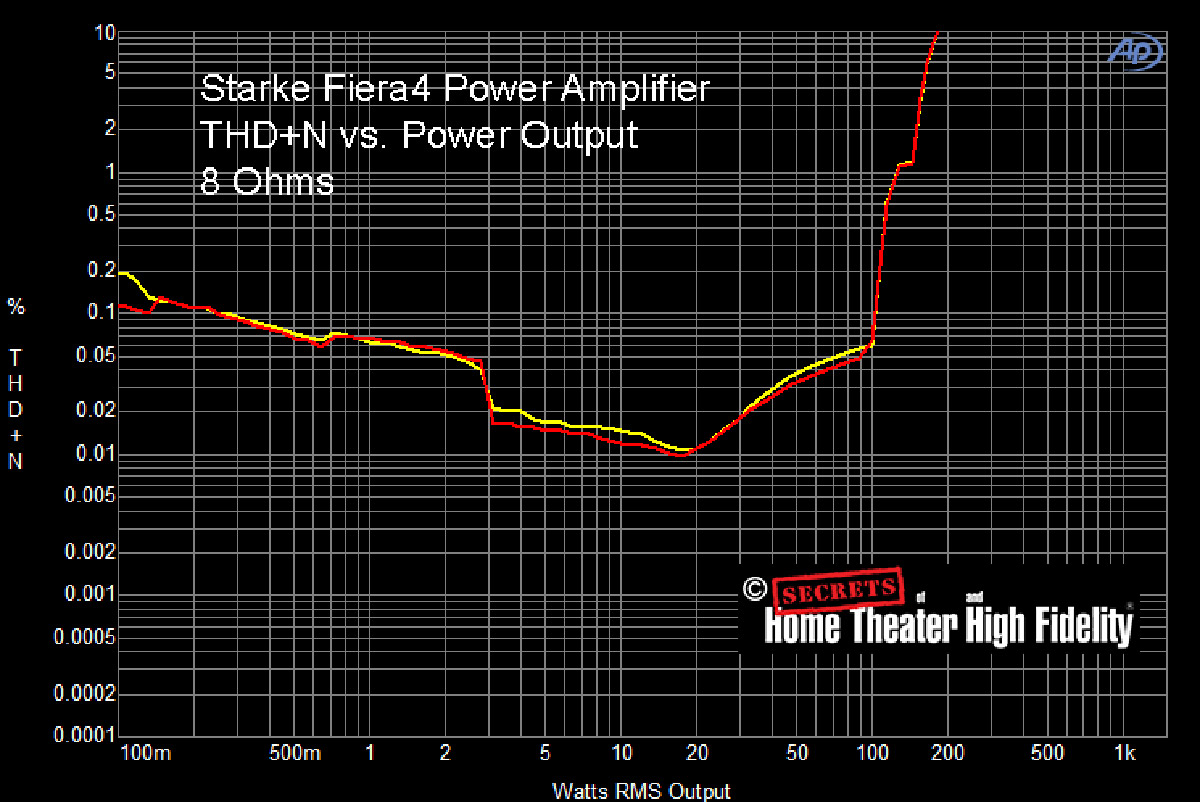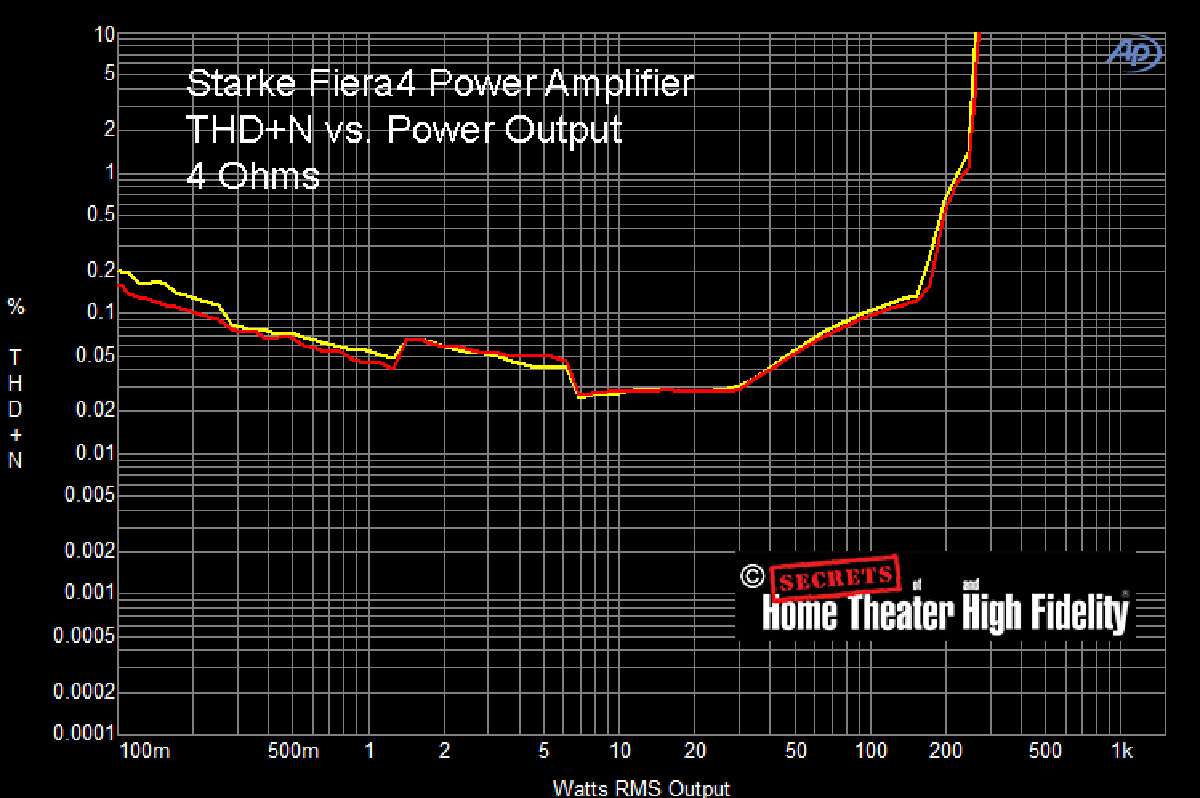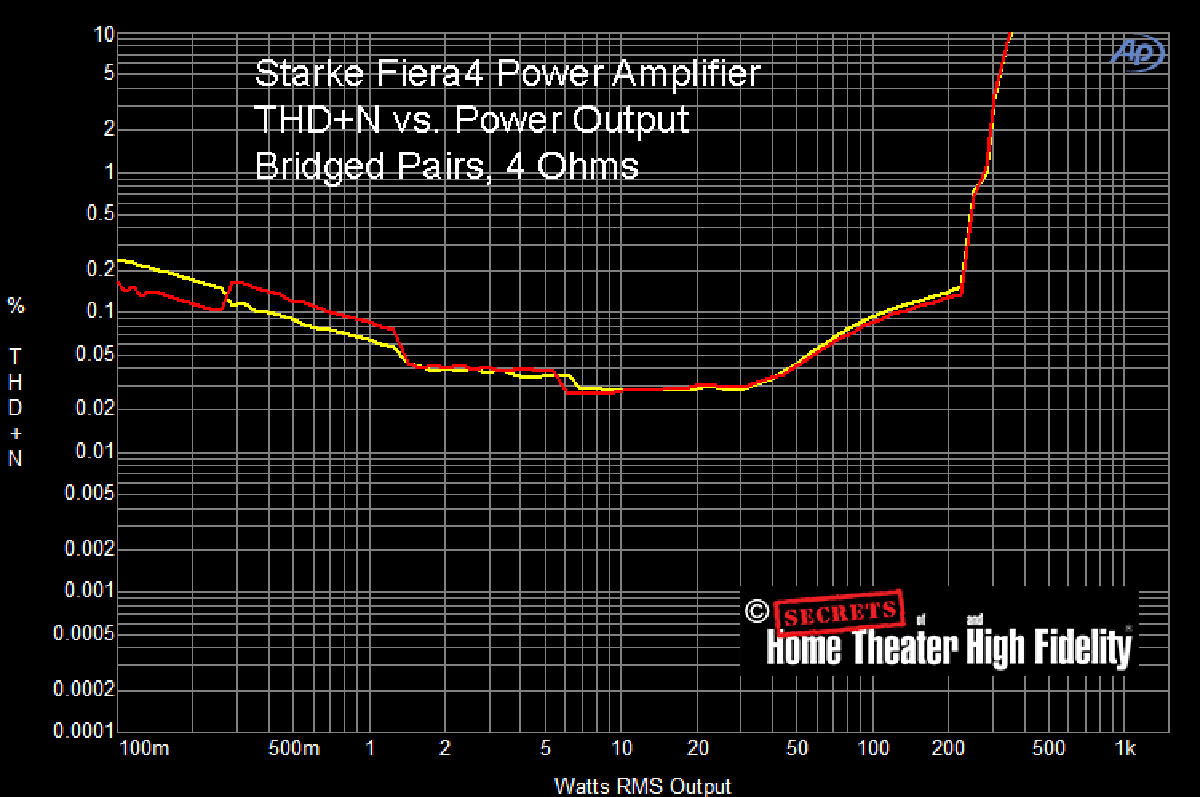Starke Sound Fiera4 Four-channel Class D Power Amplifier
- Very efficient
- Smooth sound
- Unusual noise profile
- Well built
- Four Channels can be bridged into two channels with more power
- 120V/240 V operation
Setting up a stereo system and home theater is challenging. The choices of all the gear are endless. Source, preamplifier/surround sound processor, power amplifiers, speakers, 4K flat-screen TV. Where do you begin?
Secrets Sponsor
Class of Operation:
Class D (PWM switching)
Output:
130 Watts/channel into 8 Ohms
260 Watts/channel into 4 Ohms
Case:
Aluminum
Frequency Response:
10 Hz – 20 kHz ± 2 dB
Sensitivity:
2.7 Volts input at 1 kHz, 30 Volts output
Dimensions:
5-1/2” H x 17-3/4” W x 13-1/4” D
Weight:
25.1 Pounds
MSRP:
$1,499 USD
Website:
Company:
SECRETS Tags:
Starke Sound, Fiera4, Four-channel, Class D, Power Amplifier
Secrets Sponsor
Starke Sound’s Fiera4 power amplifier is one of several products in this category for them. They also offer an eight-channel version.
The chassis is very lightweight for a four-channel power amplifier, which is the norm for Class D amplifiers.
Inside, you can see why it is so light.
The power supply is enclosed, and it has the transformers, inductors, and capacitors that are necessary.
The input AC is rectified by diodes and then passed through one capacitor that smooths the 60 Hz waveform which is now flowing in only one direction but has some ripple due to using only one capacitor. This voltage is switched at 350 kHz to produce a flat DC voltage of about 52 Volts. Even though the 60 Hz has a ripple, switching the rippled voltage allows for the voltage vs. time to be flattened by increasing the voltage in the valleys of the ripple. An inductor at the input removes high-frequency noise that could interfere with the switching.
Here is a closeup of the amplifier boards. You can see the output capacitors and inductors for each channel.
And the Switch Mode Power Supply (SMPS).
After the 52 Volts have been switched and smoothed to pure DC with no ripple, it is again switched in the amplification stage where two transistors are used to switch the positive and negative portions of the musical waveform. The voltage after switching to musical audio waveforms is about 50 Volts peak. Another capacitor and inductor at the output form an LC filter that removes high-frequency noise.
A more powerful amplifier would need bigger FETs that handle more current and voltage, but they would also have much higher gate capacitance, meaning that either the switching frequency would have to be lowered, or increase the current drive of the controller, which also comes with its own problems. So, Starke decided to make the Fiera series have modest output.
The Fiera4 has a very high switching frequency in the amplifier stage, 600 kHz. Most Class D amplifiers use 100 kHz or less. Starke designed their own amplifier stage rather than using off-the-shelf modules (from Hypex, ICEpower, or others). It allows a number of things besides custom switching frequencies. For example, the balanced inputs are converted to a balanced signal on the amplifier motherboards.
High switching frequencies allow more switches in the high audio frequency band. For example, with a 100 kHz switching frequency, there are 5 switches at 20 kHz. This results in quite a bit of distortion. Using 600 kHz produces 30 switches at 20 kHz. More data points equal less resulting distortion.
Other advantages of using higher frequencies are faster transient load response time, smaller components, and lower ripple. The transient load response is faster at higher switching frequencies because of the available increased bandwidth of the controller. Disadvantages include reduced efficiency, radio frequency noise (RF) as well as EMI, and increased loss of power.
In terms of the switching in the amplifier stage, the switching frequency is maintained, but the duty cycle is changed to vary the output level. So, for each cycle of switching, the ratio of on to off is altered, and it’s that variable duty cycle (ratio of high to low) that changes the average power delivered.
The power supplies are 52 Volts, and that allows going as high as 48 Volts DC, which translates to about 290 Watts peak, or about 145 Watts continuous into 8 Ohms (about double that into 4 Ohms). To do this, the duty cycle would be 100% – meaning for half the cycle, the load is connected to the +52 Volts rail. There is about a 4 Volt drop across the FETs/filters, so the amplifier has around +48 Volts output. Then for the other half of the cycle, the power supply connects to the -52 Volts rail. The output is the same, about -48 Volts DC.
Starke Sound chose to maximize lowest noise/THD at low/typical listening levels so as to improve the real-world use experience. Music and movies typically have a 20 dB crest factor (or more) which means while an amplifier may output up to 100 Watts+, 95%+ of the time is spent down in the 1-2 Watts range. They could have improved the performance at the 100 Watts range, but it meant sacrificing the signal-to-noise ratio (SNR) at the 1-2 Watts level. Since most listening is at low wattage, masking would not be as strong. It’s easier to hear an 80 dB noise floor at 1 Watt than it is to hear a 65 dB noise floor at 100 Watts.
As a result, and as you will see, there is a higher noise floor at higher wattage output. The noise tends to mask most of the harmonics so that there are smaller peaks above the noise floor than if the noise floor were lower.
The rear panel, shown below, has four sets of balanced/unbalanced inputs, switches to select either balanced or RCA inputs, two switches to select bridging between two amplifier modules to produce one amplifier, four sets of speaker output jacks that accept bare wire, spade lugs, or banana plugs. The requisite AC input socket (three prongs) and on/off toggle are in the right bottom corner. There is also a switch to select 120 V or 240 V supply.
For the review, I used a Win 11 laptop feeding the DAC via USB in an AURALiC ALTAIR G1 Digital Audio Streamer. The DAC’s balanced analog outputs were connected to a Pass Labs Xs Stereo Preamplifier which drove the Fiera4 amplifier. I used a pair of Carver Platinum Mark IV Ribbon Speakers. I also connected it to the Carvers and a pair of Focal ARIA stand-mounted speakers or a pair of Sonus faber Lumina II stand-mounted speakers. In this case, an Emotiva RMC-IL SSP was used to drive the four channels in the Fiera4.
Complete List of Reference Components: OPPO BDP-105 Universal Player (4), OPPO UDP-205 Universal Player (2), VPI-HR-X Turntable with Sumiko Starling and Palos Santos MC Cartridges, Otari MX-5050B-III-2 Reel-to-Reel Tape Deck, Otari MX-5050B-IV-2 Reel-to-Reel Tape Deck, AURALiC ALTAIR G1 Digital Audio Streamer, Manley Labs Steelhead Tube Phono Preamplifier (2), Balanced Audio Technology VK-5i Pure Class A Triode (Tube) Stereo Preamplifier (2) (Fully Balanced), Balanced Audio Technology VK-500 Solid State Stereo Power Amplifier (Fully Balanced) (250 Watts per Channel), Pass Labs Xs Stereo Preamplifier, Pass Labs XP-20 Stereo Preamplifier, Pass Labs XP-27 Phono Preamplifier, Pass Labs Xs 300 Monoblock Pure Class A Power Amplifiers (2) (300 Watts/each), Parasound JC 1+ Monoblock Power Amplifiers (2), Lamm LL1 Signature Stereo Pure Class A Triode (Tube) Preamplifier, Bryston BR-20 Stereo Preamplifier, MartinLogan CLX Full-Range Electrostatic Speakers (2), Sonus faber Lilium Speakers (2), Paradigm Reference Signature SUB 2 Subwoofers (2), SVS PB16-Ultra Subwoofer, MartinLogan Balanced Force 212 Subwoofer, Velodyne DD-18+ Subwoofer, Custom-Built Computer for Audio Analysis, Accupel HDG-3000 Digital Color Signal Generator (1080i capable), Component Video and DVI Output, ColorFacts Pro Video Test and Calibration Software, Version 6.0, Spyder Sensor, SpectraPlus Audio Analysis Software, Audio Precision SYS-2722 Spectrum Analyzer, Staco 3PN2210B-DVM 22 Ampere Variable Transformer (for adjusting line voltage to 120 volts during amplifier power output tests), Classé SSP-800 Surround Sound Processor, Emotiva RMC-IL 9.1.6 Surround Sound Processor, Classé CA-5200 Five-Channel Power Amplifier (200 Watts per Channel), Pass Labs X600.8 Power Amplifiers (4) (600 Watts/Each), Carver Platinum Mark IV Ribbon Speakers (2), MartinLogan Summit X Hybrid Electrostatic Speakers (2) (Rear Left/Right), MartinLogan Stage X Hybrid Electrostatic Speakers (3) (Center and Sides Left/Right), HiFiMAN HE1000 Planar Magnetic Headphones, OPPO PM-1 Planar Magnetic Headphones, Sennheiser HD 660S Headphones, OPPO HA-1 Headphone Amplifier, Bryston BUC-1 USB Converter, Sony VPL-HW55ES 1,920 x 1,080p Digital Projector, 90″ (Diagonal) Stewart Grayhawk Projection Screen, Sony 75″ UHD (4K) Flat Panel Display, Clarus Audio Cables, Clarus Concerto Power Conditioner with Crimson Power Cable.
Let’s begin with my favorite classical jazz saxophonist, Art Pepper.
Mel Torme with the Marty Paich Dek-Tette, Art Pepper – Bethlehem Records – January 28, 2014 – 24/96 sampling on Qobuz
Mel Tormé (1925-1999) is a very important jazz singer from a long time ago. He composed “The Christmas Song” (Chestnuts Roasting on an Open Fire), and his nickname was “The Velvet Fog”. He had an incredibly beautiful voice, both tenor and baritone, but tenor was where he shined the brightest. This album has some favorites, and the Fiera4 was as smooth as the Fog himself. Note the album cover art above is made from the placement of small photos of cars.
Something Tomorrow, Enrico Pieranuzi – Storyville Records – May 6, 2022 – 24/96 sampling on Qobuz
I have to look hard to find modern jazz that sounds like the classic jazz that I love so much. This album comes close. Pieranuzi is a jazz pianist. The group is perfectly microphoned, something that was not the case for jazz in the 1950’s, as stereo was new. The Fiera4 did well here too. Piano is complex, but the amplifier was up to the task.
Future Revolution: World Orchestra, Marvel – Hollywood Records – May 2, 2022 – 16/44.1 on Qobuz
I have not gone to the theater to see a Marvel superhero movie, but I do like motion picture musical scores, so I tried this one. Modern films have lots of CGI for visuals and sound in every channel for the audio. The audio here was full-bodied and intense, but the Fiera4 handled it with ease. Keep in mind that the power (Watts) output of the Fiera4 is modest, so don’t press the pedal to the metal on the volume control. Be realistic and enjoy.
Scarlatti Sonatas, Wolfram Schmitt-Leonardy: Piano – Piano Classics – May 27, 2022 – 24/96 sampling on Qobuz
Piano in a jazz ensemble is one thing, but solo piano is another. Domenico Scarlatti was born in Naples, Italy in 1685 and spent his time as a royal court composer for the Spanish and Portuguese families. His music was originally intended for harpsichord and was composed in the heart of the Baroque period. It is beautifully played by Schmitt-Leonardy here, and it sounded beautiful too.
The Very Best of Stan Getz, Stan Getz – Verve Reissues – March 12, 2002 – 16/44.1 sampling on Qobuz
Speaking of classic jazz, it doesn’t get any better than Stan Getz on tenor sax. A classic jazz musician playing classics themselves, such as “Stella by Starlight”, “East of the Sun”, “My Funny Valentine”, and others. Saxophone can sometimes be a bit raspy because of the wooden reed, but the Fiera4 is very smooth due to its noise profile, see On the Bench.
At 1 kHz, 500 mV input and 6 Volts output, 8 Ohms load, THD+N was 0.022%. I can only test two channels at a time, and unless noted, two channels non-bridged were in the tests. The bandwidth, except for the Frequency Response, was 80 kHz. I used the balanced inputs.
At 4 Ohms and the same input, 500 mV, distortion went up a bit, and so did the noise floor.
At 12 Volts out into 8 Ohms, there are more peaks, but the 2nd and 3rd harmonics look better with a higher 2nd ordered harmonic in relation to the 3rd.
At 4 Ohms, the 3rd harmonic is again predominant.
Increasing the output to 24 Volts, at 8 Ohms load, THD+N s 0.054%. This is 72 Watts which getting pretty loud.
At 4 Ohms load, THD+N is 0.129%, and the noise floor is creeping up.
At 30 Volts output into 8 Ohms (112.5 Watts), here is where the unique design of the Fiera4 is shown. The noise floor is raised from -100 dBV to -80 dBV, and that will help mask the distortion.
With a 4 Ohm load, the noise floor increases to -70 dBV. It’s like a white noise mask.
So, let’s take a look at another standard test, which is the 19 kHz, 20 kHz pair. First, 4.5 Volts output into 8 Ohms. This is a stressful test, obviously. That is why we use it.
Same input voltage, but the output is less, due to the 4 Ohm load. The noise is the main difference.
As we increase the output voltage, the most obvious change is the noise floor. This is the design, and it is on purpose. Starke Sound changed the design and just listened rather than doing bench tests. When they found the sound that was the most pleasing, that was it, and let the bench tests be where they may. I know of one other company that designs their amplifiers to have a pleasing sound rather than for the specifications. They produce Class A and Class A/B amplifiers. Starke Sound is the first company I have seen that has done this with a Class D amplifier.
The standard IMD (Inter-modulation Distortion) test uses a 60 Hz sine wave and 7 kHz sine wave at 1:4 ratio (the 60 Hz signal is four times as much as the 7 kHz signal).
What we see with increasing voltage outputs (more Watts) is similar to the results of the 19 kHz, 20 kHz tests: more distortion with increases in the noise floor.
Here are THD+N vs. Frequency curves. The first one shows 6 Volts and 30 Volts output into 8 Ohms. At 30 Volts output, the curve is complicated by the high noise floor which is part of the computation.
At 4 Ohms, the curves are higher, and I had to accept a lower high voltage output because the amplifier has a current limit.
THD+N vs. Power Output into 8 Ohms is shown below. Power at clipping (1% THD+N) is 130 Watts.
At 4 Ohms, clipping occurs at 240 Watts.
I tested the bridging function with switching it into effect while the amplifier was powered on, but no signal going through. Then I ran the distortion vs. power test. Distortion was very high. I powered off the amplifier by using the rear panel toggle, then waited a few minutes and powered it back on again. I ran a 1 kHz sine wave distortion test, and it was the same as the original test. You are not supposed to switch into bridged mode with power on, but I wanted to see what the weaknesses were. I do not suggest you try this. I already did. I suspect if you switch into bridged mode with music playing and significant wattage flowing through the amplifier, something very discouraging would happen.
Bridging four channels into two and testing at 4 Ohms yielded 280 Watts, but again, the computation is affected by the high noise, so I would estimate that the actual signal power below clipping is somewhat more. Perhaps AC voltage sags too, and that is something that is always worrisome with higher power amplifiers.
The Frequency Response is shown below, with the second graph having an expanded Y axis. The graphs show that the response is flat to about 2 kHz and then begins to go up with an 8 Ohm load and down with a 4 Ohm load. This means the response is load-dependent. Listening would have a slightly brighter high end with 8 Ohm speakers (assuming 20 kHz hearing limit) and slightly rolled off high end with 4 Ohm speakers. Most speakers have a widely variable impedance vs. frequency, so the listening results would vary as well.
A video describing the Starke Sound Fiera4 power amplifier can be seen here: https://www.youtube.com/watch?v=dwink1ZKTpA.
The new Starke Sound Fiera4 Class D power amplifier has a unique design and unique sound.
- Stays cool
- Very smooth sound
- Four channels in a lightweight chassis
- Modest price
- 500 Watt/channel stereo model down the road, optimized for low distortion and noise throughout the audio band. Damn the complications.
It was designed with the sound in mind rather than the specifications, and it works. I like it very much. For those consumers who are starting out in consumer audio and want something that can take the edge off digital recordings, this could be a nice choice for an entry-level stereo, bridging the four channels into two. If you expand a stereo system to being a home theater, it could go back to being four channels and be used with the surround speakers.


